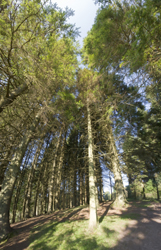Carbon sequestration in experimental studies
The EC-funded EUROFACE project concentrated on the role of forest plantations to reduce greenhouse gases. The hypotheses put forward by partners were tested using a technology termed FACE (Free Air CO2 Enrichment) used to expose specific predefined open-air areas to elevated levels of carbon dioxide without altering overall climatic conditions in the test areas. The use of FACE technology allows scientists to measure and monitor the effects of elevated carbon dioxide levels in the ecosystem. A research team from the University of Wales focused on the use of short rotation forestry (SRF) plantations in order to evaluate their long-term potential in carbon sequestration. The studies showed that increasing the levels of CO2 in the region resulted in an increase in carbon levels below ground as expected. Extension of the research would be to follow the path of the stored carbon and how this will affect overall balance of the surrounding system. It is already known that increased CO2 can result in direct increases in the volume of the root system. Understanding the entire scope and interdependencies of events that emanate from increases in atmospheric carbon dioxide is currently the topic of intense research globally. The importance of the experimental parameters is therefore extremely high and further research can aid scientists construct the correct experimental framework.







